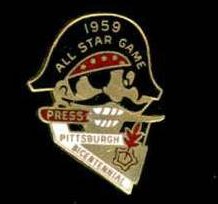1959 Pittsburgh PIRATES ALL-STAR GAME Press Pin (w/LOA & other doc.)
Four currently on eBay between $199 and $225.

Please wander around the website for more info, prices, values & images
on vintage baseball, football, basketball, hockey, sport and non-sports cards.
1934,1935,1936 Diamond MatchbooksDuring much of the Great Depression, matchbook collecting swept the country ! Sports matchbooks started appearing in the 1930s, most issued by Diamond Match Company of New York. Over the next few years, several series were issued with similar designs; b/w photo of the player on front with short write-up and stats on back. The player's name and team was also printed on the 'saddle'.
Please consider the following info as approximate. 1935's issue was tiny with only 24 total covers (8 red,8 blue,8 green). A third series was later released with 200 or more different covers (players/colors). 1930's matchbook covers appear to be huge bargains for collectors as their current values are fractions of the value of Goudey and other baseball cards from the same era.
Click for complete
1935-1936 Diamond Matchbook Checklist and Prices
|

1954 Bowman Baseball |

Topps Vault & Proofs
Auctioneer Guernsey's went thru Topps offices gathering over 3,000
items for the auction. Topps spokesman reported auction sales of
OVER $1.5 million !!! Additional sales were made from a mail-only
auction. Collector Keith Olbermann, at the auction, described it
as an archaeological dig.
Click for complete
Topps Vault, Proofs & Blank-Backs
Topps archive material continued to accumulate after the auction
ending up with another treasure of over 250,000 transparencies,
uncut sheets, color separations, art, photos, slides, proof sheets
& wrappers, canceled checks, contracts and one-of-a-kind
items to sell.
Note: You may be on that page right now. |

The first baseball trading cards date back to 1869. For many years, baseball cards were packaged in packs of tobacco as a way to increase sales the same way that today prizes are packaged in boxes of cereal. In the 1920's and 1930's, candy and gum companies started packaging baseball cards in their products as well.
Baseball card production was virtually halted in the early 1940's due to paper shortages created by World War II. The "Modern Era" of baseball cards began in 1948 when Bowman Gum Inc. offered one card and one piece of gum in a pack for a penny.
The first important football set was the Mayo set featuring college players in 1984. Other than the 1935 National Chicle set no other key football set was issued until 1948 when noth Bowman and Leaf produced sets.
 Perhaps distracted by it's competition with Topps, the 1954 Bowman set was
filled with errors and variations. Nearly 20% (40/224 cards) had some sort
of variation, with some having more than 2.
Perhaps distracted by it's competition with Topps, the 1954 Bowman set was
filled with errors and variations. Nearly 20% (40/224 cards) had some sort
of variation, with some having more than 2.  TOP ROOKIES: Don Larsen, Harvey Kuenn, Frank Thomas
TOP ROOKIES: Don Larsen, Harvey Kuenn, Frank Thomas 